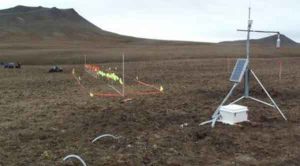
SAN FRANCISCO — On rare winter mornings here, a skim of ice forms on sidewalk puddles. But water’s solid form is mostly an abstraction in this land of blooming flowers and the hummingbirds that visit them. Except for the week of the fall meeting of the American Geophysical Union.
Dozens of the 22,000 scientists gathering here for the week are talking about ice, mostly about how much of it is disappearing, and how quickly that is happening.
In the 1980s, ice floating on the northern ocean in September was about the size of the continental United States. Now, fall sea ice covers an area about half the size, from Kansas west to the California coast.
That shrinking disc of ice on top of the world is allowing more of the sun’s heat to be stored in the ocean, which causes more ice to melt.
“Sea ice reflects 80 percent of the sunlight that hits it,” said Don Perovich of Dartmouth University, a sea-ice specialist who spoke at a packed press conference. “The ocean absorbs more than 90 percent of all sunlight. A small change can make a big change.”[xyz-ihs snippet=”Adsense-responsive”]Northern sea ice hit a record low extent in November, as determined by satellites that have allowed us to monitor it since 1979. While the ice will endure during the frigid polar winter, scientists think summer sea ice might be gone as soon as 2040.
Northern sea ice has been around for thousands of years, according to Christof Pearce of Stockholm University, who presented a poster at the conference. He recently took a cruise on the icebreaker Oden from Norway to Alaska and back. From the deck, he pulled up cores of ocean bottom sediment from an underwater canyon northwest of Wrangel Island. Within them, he found the molecular remains of diatoms, single-celled algae that live in sea ice.
Some of them were alive 4,000 years ago. He said sea ice has probably been around for that long, at least seasonally. But his little sea ice indicators have “really been dwindling in the last 50 years.”
Perovich said northern sea ice could regain its America-size coverage if northern temperatures drop, but since the top of the globe had its warmest year on record in 2016, a rebound does not seem likely.
Ice on land is shrinking too. The melting season on Greenland is now one month longer than the 1951 to 2010 average, said Marco Tedesco of Columbia University. Because of that, Greenland is losing 450 gigatons of ice per year to the ocean. What does that number mean? Reporter Chris Mooney of the Washington Post equated one gigaton to 6 million blue whales. Or 100 million African elephants.
Ice in the ground is also vanishing, in places where it should not. Louise Farquharson of UAF showed photos of study sites in the high arctic of Canada. There, at places called Green Cabin, Mould Bay and Isachsen, scientists have for years measured what they considered “cold permafrost” many degrees below the freezing point.
But even that is thawing, as can be seen in photographs Farquharson showed. As recently as 2010, the tabletop plains were pleasant to hike, even with one’s eyes closed. Now, the ground is bumpy and confused, the result of ancient ice wedges that have thawed.
Why is that ice disappearing now? Farquharson thinks it is because air temperatures have been warmer (more “thawing degree days”) and because there is very little ground cover above the ice.
“It has no blanket,” she said. “It’s naked.”
An audience member asked Farquharson if the abrupt change from a flat surface to a rumpled one is a sign of change modern humans have not experienced.
“Those ice wedges were probably 1,000, maybe 2,000 years old,” she said. “I would imagine this is unprecedented.”
Source: Geophysical Institute
